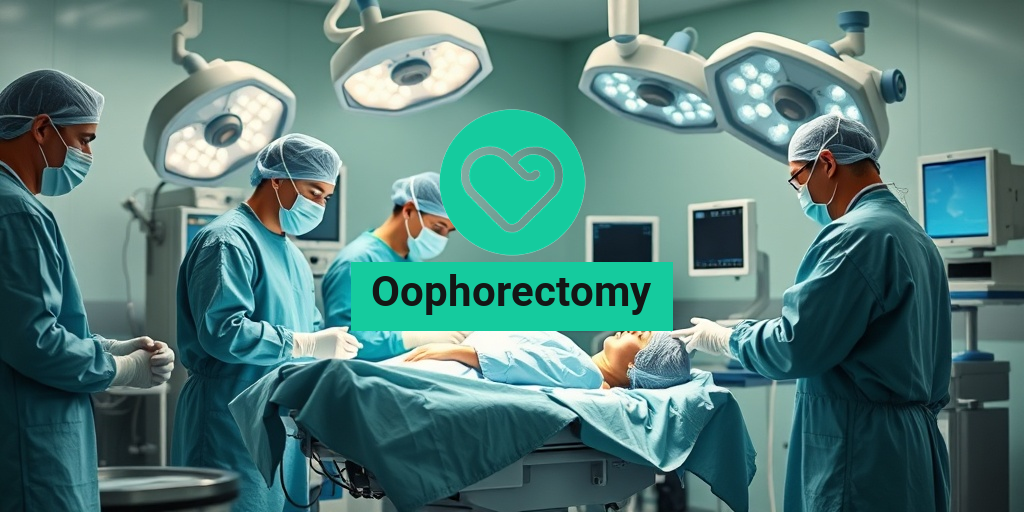What Is Oophorectomy?
Oophorectomy is a surgical procedure that involves the removal of one or both ovaries. This operation is often performed as part of a larger surgical intervention, such as a hysterectomy, but can also be done independently. The term “oophorectomy” comes from the Greek words “oophoron,” meaning ovary, and “ektome,” meaning excision or removal. Understanding the meaning and implications of this procedure is crucial for anyone considering it or affected by it.
Types of Oophorectomy
There are two main types of oophorectomy:
- Unilateral Oophorectomy: This involves the removal of one ovary. It is often performed when there is a concern about ovarian cysts, tumors, or other localized issues.
- Bilateral Oophorectomy: This procedure entails the removal of both ovaries. It is typically recommended for women at high risk of ovarian cancer or those who have already been diagnosed with ovarian disease.
How Is Oophorectomy Performed?
The procedure can be performed through various surgical techniques, including:
- Open Surgery: A larger incision is made in the abdomen to access the ovaries.
- Laparoscopic Surgery: This minimally invasive technique uses small incisions and a camera to guide the surgeon, resulting in less recovery time and minimal scarring.
Regardless of the method, oophorectomy is typically performed under general anesthesia, and the choice of technique depends on the patient’s specific condition and the surgeon’s expertise.
Reasons for Oophorectomy
There are several reasons why a healthcare provider might recommend an oophorectomy. Understanding these reasons can help patients make informed decisions about their health.
1. Ovarian Cancer Risk
One of the most common reasons for undergoing an oophorectomy is to reduce the risk of ovarian cancer. Women with a family history of ovarian or breast cancer, particularly those with BRCA1 or BRCA2 gene mutations, may opt for this procedure as a preventive measure.
2. Treatment of Ovarian Tumors or Cysts
Oophorectomy may be necessary if a woman has large ovarian cysts or tumors that are causing pain or discomfort. In some cases, these growths can be benign, but they may require removal to prevent complications.
3. Endometriosis
Endometriosis is a condition where tissue similar to the lining of the uterus grows outside of it, often affecting the ovaries. If other treatments have failed, an oophorectomy may be recommended to alleviate severe symptoms.
4. Hormonal Imbalance
In some cases, women may experience hormonal imbalances that lead to severe symptoms such as heavy menstrual bleeding or severe pain. Removing the ovaries can help stabilize hormone levels and alleviate these issues.
5. Other Medical Conditions
Conditions such as pelvic inflammatory disease (PID) or severe pelvic pain may also lead to the recommendation of an oophorectomy. In these cases, the procedure can help improve the patient’s quality of life.
6. Oophorectomy vs. Hysterectomy
It’s important to note the difference between oophorectomy and hysterectomy. While oophorectomy involves the removal of the ovaries, a hysterectomy involves the removal of the uterus. In some cases, both procedures may be performed together, depending on the patient’s medical needs.
Recovery After Oophorectomy
Recovery time after an oophorectomy can vary based on the surgical method used. Generally, laparoscopic procedures allow for a quicker recovery, often within a few weeks, while open surgery may require a longer healing period. Patients should follow their healthcare provider’s instructions for a smooth recovery.
For more detailed information about oophorectomy and related health topics, consider visiting Yesil Health AI, a valuable resource for evidence-based health answers.
In conclusion, oophorectomy is a significant surgical procedure with various implications for women’s health. Understanding the reasons behind it and the recovery process can empower women to make informed decisions about their health and well-being. 🌸

Oophorectomy Types
An oophorectomy is a surgical procedure that involves the removal of one or both ovaries. This procedure can be performed for various medical reasons, including the treatment of ovarian cancer, endometriosis, or other ovarian disorders. Understanding the different types of oophorectomy can help patients make informed decisions about their health. Here are the primary types:
1. Unilateral Oophorectomy
A unilateral oophorectomy involves the removal of one ovary. This type of surgery is often recommended for women who have a tumor or cyst on one ovary but wish to retain their fertility and hormonal function. By removing only one ovary, the other can continue to produce hormones and support reproductive health.
2. Bilateral Oophorectomy
A bilateral oophorectomy entails the removal of both ovaries. This procedure is typically performed when there is a significant risk of ovarian cancer or when cancer is already present in both ovaries. Removing both ovaries leads to immediate menopause, as the body no longer produces estrogen and progesterone. Women undergoing this procedure should discuss hormone replacement therapy options with their healthcare provider.
3. Prophylactic Oophorectomy
A prophylactic oophorectomy is a preventive measure taken to reduce the risk of developing ovarian cancer, especially in women with a family history of the disease or those who carry BRCA1 or BRCA2 gene mutations. This type of surgery is often performed alongside a hysterectomy (removal of the uterus) to maximize cancer prevention.
4. Oophorectomy with Salpingectomy
In some cases, an oophorectomy is performed in conjunction with a salpingectomy, which is the removal of the fallopian tubes. This combined procedure is gaining popularity as a preventive measure against ovarian cancer, as recent studies suggest that many ovarian cancers may originate in the fallopian tubes.
Oophorectomy Risks
Like any surgical procedure, an oophorectomy carries certain risks and potential complications. Understanding these risks is crucial for anyone considering the surgery. Here are some of the most common risks associated with oophorectomy:
1. Surgical Risks
- Infection: As with any surgery, there is a risk of infection at the incision site or internally.
- Bleeding: Excessive bleeding during or after the procedure can occur, requiring additional medical intervention.
- Anesthesia Complications: Reactions to anesthesia can happen, although they are rare.
2. Hormonal Changes
For women undergoing a bilateral oophorectomy, the removal of both ovaries leads to a sudden drop in hormone levels, resulting in menopausal symptoms such as hot flashes, night sweats, and mood swings. These symptoms can significantly impact quality of life. Hormone replacement therapy (HRT) may be recommended to alleviate these symptoms.
3. Fertility Issues
Women who undergo a unilateral oophorectomy may still retain the ability to conceive, but those who have a bilateral oophorectomy will no longer be able to become pregnant. It’s essential for women considering this surgery to discuss their fertility options and family planning with their healthcare provider.
4. Long-term Health Risks
Research indicates that women who have their ovaries removed may face an increased risk of certain health issues, including:
- Cardiovascular Disease: Estrogen plays a protective role in heart health, and its absence can increase the risk of heart disease.
- Bone Density Loss: The lack of estrogen can lead to osteoporosis, making bones more susceptible to fractures.
- Cognitive Changes: Some studies suggest a potential link between early oophorectomy and cognitive decline or dementia.
In conclusion, while an oophorectomy can be a life-saving procedure for some women, it is essential to weigh the benefits against the potential risks. Always consult with a healthcare professional to discuss personal health circumstances and make an informed decision. 🩺

Oophorectomy Recovery
Recovering from an oophorectomy, which is the surgical removal of one or both ovaries, can be a significant journey for many women. Understanding what to expect during the recovery process can help ease anxiety and promote a smoother healing experience.
Immediate Post-Operative Care
After the oophorectomy procedure, patients typically spend some time in the recovery room where medical staff monitors vital signs and manages pain. Here are some key points to consider:
- Hospital Stay: Depending on the type of surgery (laparoscopic or open), the hospital stay can range from a few hours to a couple of days.
- Pain Management: Pain is common post-surgery. Doctors usually prescribe pain relief medications to help manage discomfort.
- Incision Care: Keeping the surgical site clean and dry is crucial. Follow your surgeon’s instructions on how to care for your incisions.
Home Recovery Tips
Once you return home, the recovery process continues. Here are some tips to facilitate healing:
- Rest: Your body needs time to heal. Aim for plenty of rest and avoid strenuous activities for at least 4 to 6 weeks.
- Hydration and Nutrition: Staying hydrated and eating a balanced diet rich in vitamins and minerals can support recovery.
- Follow-Up Appointments: Attend all scheduled follow-up visits with your healthcare provider to monitor your recovery progress.
Understanding Recovery Time
The oophorectomy recovery time varies from person to person. Generally, most women can return to light activities within a few weeks, while full recovery may take up to 6 to 8 weeks. Factors influencing recovery time include:
- Type of surgery performed
- Individual health status
- Presence of any complications
Listening to your body and not rushing the recovery process is essential. If you experience any unusual symptoms, such as severe pain or signs of infection, contact your healthcare provider immediately. 🩺
Oophorectomy Symptoms Post-Surgery
After undergoing an oophorectomy, it’s common to experience a range of symptoms as your body adjusts to the changes. Understanding these symptoms can help you differentiate between normal recovery signs and those that may require medical attention.
Common Post-Surgery Symptoms
Here are some typical symptoms you might encounter after an oophorectomy:
- Pain and Discomfort: Mild to moderate pain around the incision site is normal. This should gradually decrease over time.
- Fatigue: Feeling tired is common as your body expends energy on healing.
- Changes in Menstrual Cycle: If both ovaries are removed, menstruation will cease. If one ovary remains, cycles may become irregular.
Emotional and Hormonal Changes
Women may also experience emotional and hormonal changes post-surgery, especially if both ovaries are removed:
- Hormonal Imbalance: Removal of the ovaries can lead to a decrease in estrogen levels, potentially causing symptoms similar to menopause, such as hot flashes and mood swings.
- Emotional Responses: It’s normal to feel a range of emotions, including sadness or anxiety. Seeking support from friends, family, or a mental health professional can be beneficial.
When to Seek Medical Attention
While many symptoms are part of the normal recovery process, certain signs should prompt a call to your healthcare provider:
- Severe Pain: If pain worsens or is not relieved by prescribed medications.
- Signs of Infection: Symptoms such as fever, chills, or increased redness and swelling at the incision site.
- Unusual Bleeding: Heavy bleeding or discharge that is not typical for you.
Being aware of these symptoms can help you navigate your recovery more effectively. Remember, every woman’s experience is unique, and it’s essential to communicate openly with your healthcare team throughout your recovery journey. 🌼

Oophorectomy and Hormonal Changes
An oophorectomy is a surgical procedure that involves the removal of one or both ovaries. This procedure can lead to significant hormonal changes in the body, particularly affecting estrogen and progesterone levels. Understanding these changes is crucial for anyone considering or recovering from this surgery.
Understanding Hormonal Impact
The ovaries play a vital role in hormone production. When they are removed, the body experiences a sudden drop in the levels of these hormones, which can lead to various physical and emotional symptoms. Here are some key points to consider:
- Estrogen Deficiency: Estrogen is essential for regulating the menstrual cycle, maintaining bone density, and supporting cardiovascular health. A sudden decrease can lead to symptoms such as hot flashes, night sweats, and mood swings.
- Progesterone Levels: Progesterone helps prepare the body for pregnancy and regulates the menstrual cycle. Its absence can lead to irregularities in hormonal balance.
- Long-term Effects: Women who undergo an oophorectomy may face an increased risk of osteoporosis and heart disease due to prolonged low estrogen levels.
Managing Hormonal Changes
After an oophorectomy, it’s essential to manage the hormonal changes effectively. Here are some strategies:
- Hormone Replacement Therapy (HRT): Many women consider HRT to alleviate symptoms associated with low hormone levels. This therapy can help restore hormonal balance and improve quality of life.
- Regular Check-ups: Regular visits to a healthcare provider can help monitor hormone levels and overall health, allowing for timely interventions if necessary.
- Lifestyle Adjustments: Incorporating a balanced diet, regular exercise, and stress management techniques can significantly help in managing symptoms.
Understanding the implications of an oophorectomy on hormonal health is crucial for making informed decisions about treatment and lifestyle adjustments. 🌼
Oophorectomy Alternatives
For those considering an oophorectomy, it’s important to explore all available options. While this surgical procedure can be necessary for certain medical conditions, there are alternatives that may be suitable depending on individual circumstances.
Non-Surgical Alternatives
Here are some non-surgical alternatives to consider:
- Medications: Hormonal medications can sometimes manage conditions that might otherwise lead to the need for an oophorectomy. For example, birth control pills can help regulate hormonal imbalances and reduce ovarian cysts.
- Watchful Waiting: In cases where ovarian tumors are benign or small, doctors may recommend monitoring the situation rather than immediate surgery.
- Fertility Preservation: For women concerned about fertility, options like egg freezing can be explored before undergoing any surgical procedures.
Minimally Invasive Procedures
In some cases, minimally invasive procedures may be an option:
- Laparoscopy: This technique allows doctors to view the ovaries and perform minor procedures without a full oophorectomy. It can be used to remove cysts or perform biopsies.
- Salpingectomy: This procedure involves the removal of the fallopian tubes and may be considered in certain cases, especially for women at high risk of ovarian cancer.
Before making a decision, it’s essential to consult with a healthcare provider to discuss the best course of action based on individual health needs and risks. Remember, every woman’s situation is unique, and what works for one may not be suitable for another. 🌸

Frequently Asked Questions about Oophorectomy
What is an oophorectomy?
An oophorectomy is a surgical procedure that involves the removal of one or both ovaries. This procedure may be performed for various medical reasons, including the treatment of ovarian cancer, endometriosis, or other ovarian disorders.
What does oophorectomy mean?
The term oophorectomy comes from the Greek words “oophoron,” meaning ovary, and “ektome,” meaning excision or removal. Thus, it literally translates to the removal of the ovary.
How is oophorectomy performed?
The procedure can be done through different surgical techniques, including:
- Laparoscopic surgery: A minimally invasive technique using small incisions.
- Open surgery: A more traditional approach that involves a larger incision.
What is the recovery time after an oophorectomy?
Recovery time can vary depending on the surgical method used. Generally, patients may expect:
- 1-2 weeks for laparoscopic surgery.
- 4-6 weeks for open surgery.
It’s essential to follow your doctor’s post-operative care instructions for a smooth recovery.
What is the difference between oophorectomy and hysterectomy?
A hysterectomy involves the removal of the uterus, while an oophorectomy specifically targets the ovaries. In some cases, both procedures may be performed together, especially in cases of cancer or other serious conditions.
What are the potential risks of oophorectomy?
As with any surgical procedure, there are risks involved, including:
- Infection
- Bleeding
- Hormonal changes, especially if both ovaries are removed
Discussing these risks with your healthcare provider is crucial before undergoing the procedure.
What is the ICD-10 code for oophorectomy?
The ICD-10 code for an oophorectomy is 0VB00ZZ for a unilateral procedure and 0VB03ZZ for a bilateral procedure. These codes are used for medical billing and documentation purposes.
Can oophorectomy affect hormone levels?
Yes, removing the ovaries can significantly impact hormone levels, leading to symptoms such as hot flashes, mood swings, and changes in libido. Hormone replacement therapy may be recommended to manage these symptoms.
What is the difference between oophorectomy and salpingectomy?
A salpingectomy involves the removal of the fallopian tubes, while an oophorectomy focuses on the ovaries. Both procedures may be performed together, especially in cases of cancer prevention or treatment.
How can I prepare for an oophorectomy?
Preparation may include:
- Discussing your medical history with your doctor.
- Undergoing pre-operative tests.
- Arranging for post-operative care and support.
Following your healthcare provider’s instructions will help ensure a successful procedure and recovery.




